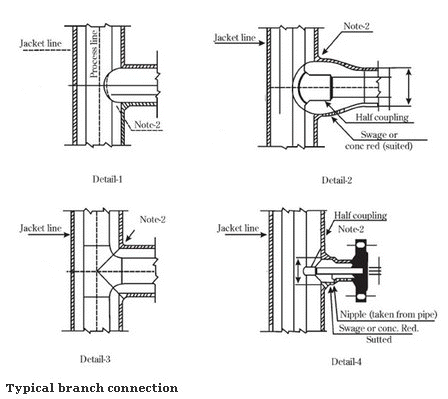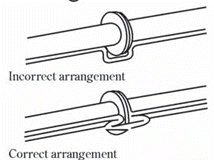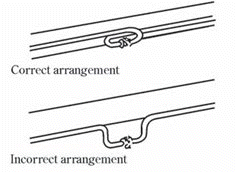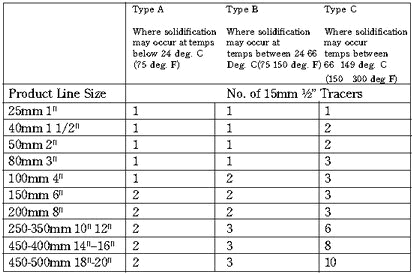 |
Satish Lele lelepiping@gmail.com |
View this page as YouTube Video Presentation

The commercial use of heat transfer compounds like steam in jacketed pipes is to keep the line hot. A steam-jacketed pipe is where the core on inner pipe containing the product fluid is surrounded by larger pipe called the jacket. Steam is carried in the annular region between the two pipes. The heat transfer coefficient for this system is very high. Typically, a jacketed system will maintain the product near the steam temperature (when there is little or no flow in the pipeline). On the negative side, the construction cost of a jacketed system is extremely high in both materials and labor. The system is very expensive to maintain. Leakage or failure of the system is difficult to locate. Where failure does occur, it is frequently due to leakage at the wall of the core pipe allowing steam to pass into the process material and vice versa. The removal of the material plugging the jacket is an expensive repair job. The usual solution is a complete replacement of the piping system. In addition the possibility of cross contamination could cause complete loss of the product. In some processes, cross contamination may be a critical hazard.
Ideally jacketed lines should be constructed in no more than 6 meters lengths and the condensate removed from each section. Steam should enter at the highest end so that there is a natural fall to the condensate out let. When it is considered impractical to trap each length, a number of lengths up to a total of 24-30 meters approx may be formed together in moderate climates, but in extremely cold parts of the world 12 meters should be maximum. Always avoid connecting solely through the bottom loop. This can only handle the condensate free of steam. Although in most cases 15 mm condensate outlet will be adequate, it is usual to make this the same size as the steam connection as it simplifies installation.
The steam jacket provides somewhat higher heat transfer rates than conduction tracers, however, frequently these higher rates are unnecessary and can cause significant energy losses. Conduction tracing, through its flexibility and sufficiently high heat transfer rates, can reduce energy consumption by adjustment of the number and size of tracers to more closely match the actual heat requirements while still providing melt out or heat up capability. Although energy savings and the resultant savings in operating and maintenance costs are of paramount interest, conduction tracing can offer substantial savings in capital outlay and future maintenance that should not be overlooked.
Fabrication and Testing: The capital cost of jacketing is high because it requires not only a larger pipe to surround the process pipe, but also special fittings, skilled welders and more trap stations. Today, fabricated jacket assemblies called spools are often built at fabrication shops and transported to the job site. Inspection and testing is quite expensive. Special testing such as dye penetrant, x-ray and hydrostatic testing increases the cost of a jacketed system even further. Construction time for jacketed pipe is quite long, and the final system cannot be easily adapted or modified. Conduction tracing, on the other hand, is more easily installed and can be readily modified to adapt to necessary changes in the process by the addition of more tracers. Reductions in capital costs are possible with conduction tracing with little decrease in system heating efficiency. Of the many advantages of conduction tracing over jacketing, the most significant today is energy savings. Though energy savings are often low on a per unit basis, they can be startling when viewed from the perspective of an operative system. Energy savings are possible with conduction tracing because the number and size of tracers can be designed to provide the appropriate heat transfer area that closely matches the heat requirement. The heat transfer area for Steam jacketing is, of course, always equivalent to the outer surface of the Core (process) pipe.
The temperature of the process liquids being transferred through pipelines often must be maintained to meet the requirements of a process, to prevent thickening and solidification, or simply as an anti-frost measure. This is achieved by the use of jacketed pipes, or by attaching to the product line one or more separate tracer lines carrying a heating medium such as steam or hot water. The steam usage may be relatively small but the tracing system is often a major part of the steam installation, and the source of many of the problems. Many large users and plant contractors have their own inhouse rules for tracer lines, but the following guide-lines may be useful in other cases.
External Tracer Lines: One or more heat carrying lines of sizes usually from 10 mm (3/8)” up to 25 mm (1") nominal bore are attached to the main product pipe. Transfer of heat to the product line may be done in three ways, by conduction through direct contact, by convection currents in the air pocket formed inside the insulating jacket, and by radiation. The tracer lines may be of carbon steel or copper, or sometimes stainless steel.






Sizing of External Tracers: The tracing or jacketing of any line normally aims at maintaining the contents of the line at a satisfactory working temperature under all conditions of low ambient temperature with adequate reserve to meet extreme conditions. On some exposed sites, with an ambient still air temperature of say -18oC the effect of a 24 km/h wind will be to lower the temperature to an equivalent of -38oC. Even 0oC in still air can be lowered to an effective -16oC with a 30 km/h wind. Such circumstances which must be taken into full consideration when studying the tracer line requirements. Most of the sizing of external tracers is done by rule of thumb. Rule of thumb practices are generally based on the experiences of a certain company on a particular process and do not necessarily apply elsewhere. There are also widely differing opinions on the layout: some say that multiple tracers should all be below the
center line of the product line whilst other say with equal conviction that it is perfectly satisfactory to space the tracers equally around the line.
 to get all the information as a eBook
to get all the information as a eBook
